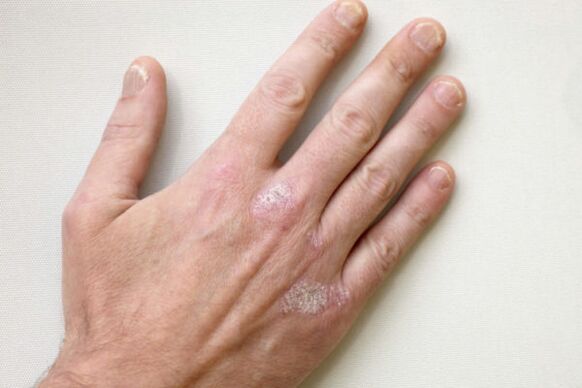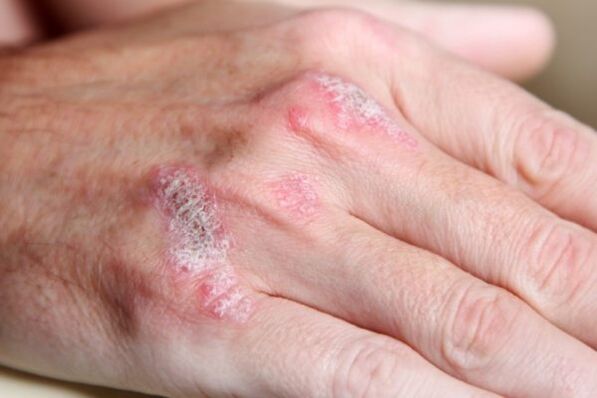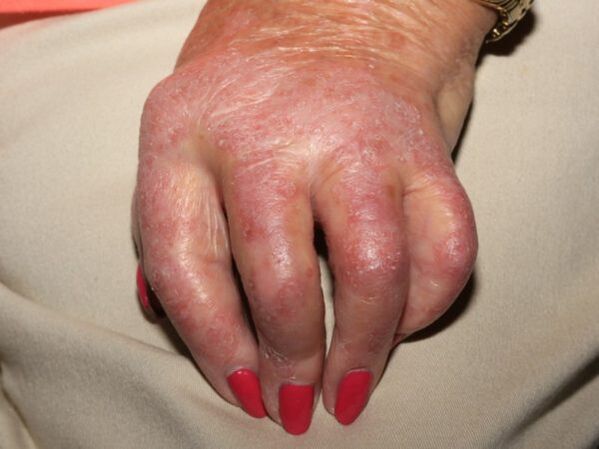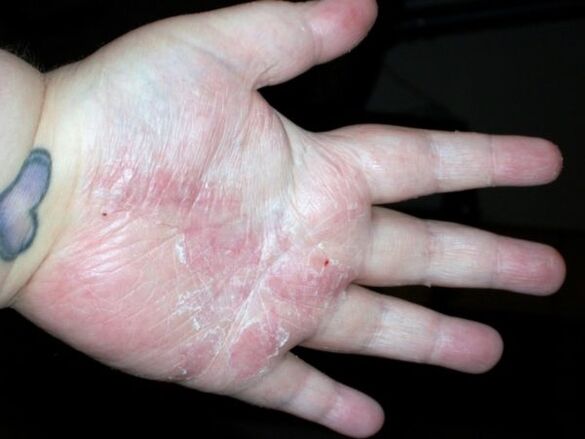Psoriasis is a chronic skin condition that cannot be completely cured. The disease requires symptomatic therapy to reduce the severity of manifestations and improve well -being. Psoriasis on the hands is a frequent pathological localization. It starts with the appearance of small plaques and can grow without proper treatment.

Causes and mechanisms of development
Psoriatic plaques on the hands, especially on the fingers, significantly affect quality of life. Although the disease is not contagious, strange skin defects are worrisome. Psoriasis is not the most pleasant disease, and not only because it looks like it, but also because of the risk of complications.
The exact etiology of the appearance of this dermatological disease has not been elucidated. Specialists identify risk factors that can influence the development of pathology. It is known that psoriasis is not contagious through contact, it cannot be transmitted through contact with patients.
It is also important not to be completely cured, therefore, throughout life, one has to take supportive agents and monitor the skin condition carefully at different times of the year. Frequent irritation in spring and winter. Scientists include the following factors in the development of this disease:
- genetic predisposition;
- immunodeficiency, decreased protective function of the body;
- frequent skin lesions caused by viruses, fungi, bacteria;
- sudden changes in climatic conditions;
- chronic skin diseases, including congenital anomalies;
- long-term use of certain medications, particularly anticonvulsants, antidepressants and steroid hormones;
- psycho-emotional burden;
- metabolic disorders in the body.
Psoriatic plaques on the hands begin to appear in small joint areas, between the fingers, near the phalanges. Pathological elements are more visible on the surface of the palm. It is most difficult to treat psoriasis from such localization, as hands are often in contact with household chemicals and other irritants.

Risk groups
The risk group for developing this disease includes men and women who often have other dermatological diseases. The likelihood of the disease increases when there are already cases of psoriasis in the family.
Pathology can occur in people with weakened immunity, in those living in unsatisfactory living conditions. Risk groups also include those who, because of their activities, are forced into contact with aggressive chemicals.
Clinical manifestation
The first signs in the early stages of the disease are a single pathological element in the hand area. Plaques can appear on the hands, fingers, back of the palms. If the nail is involved in a pathological process, there is a risk of loss of sensitivity and the appearance of tissue edema.
Increased skin dryness causes cracks in the palms. There are signs of thickening of the epidermis, which resembles calluses.

The main manifestations of psoriasis on the hands are:
- increased dryness, marked redness of the skin;
- thickening of the epidermis, increased number of fingers due to edema;
- Cracks when plaque cracks
- sometimes there is a combination of several elements with damage to healthy skin.
In winter and autumn, when cold days occur, the disease manifests itself as intense exfoliation of the skin. Without treatment, there is a possibility of scratching the hand with an infection, then the symptoms are complemented by signs of inflammation.
Pathological forms

Psoriasis on the hands can take several forms:
- On the fingers. It is indicated by exfoliation, the formation of plaques, which are often inflamed. Irritation occurs in winter. Often leads to complications.
- On the brush. It occurs in 25% of patients, the symptoms are similar to psoriasis on the fingers, while the skin in the affected area becomes rough, reddish areas appear. The patient complains of constant discomfort, active exfoliation, itching.
- Palmar-plantar. Occurs in people who do hard physical work. The soles of the feet and palms are affected. The rough skin area resembles a dense ax, and cracks very frequently appear.
- Arthropathic. Psoriasis occurs against the background of joint damage. The elements of the rash are located in the phalanges. In addition to external manifestations, patients worry about joint pain during movement, and then at rest.
- Pustular. The palms and soles of the feet are affected. Stress and hormonal pathology are risk factors. The rash has a clear border, and pustules appear. The disease is often recurrent and difficult to treat.

Each form of the disease progresses in three successive stages - early, progressive and immobile. After one cycle (through 3 stages), the deterioration of the disease begins. At this stage, the clinical signs are almost completely gone. Treatment aims to prolong the regression level as much as possible, otherwise the disease cycle repeats itself over and over again.
Differential diagnosis
Psoriasis of the hands is distinguished by pathologies such as lichen planus, Reiter’s disease, syphilis, seborrheic and atopic dermatitis.
A special feature of psoriasis during examination is the psoriatic triad, with the presence of a doctor who can diagnose. It covers the phenomenon of stearin spots, puncture bleeding and terminal film.
Methods of treatment
Although psoriasis cannot be completely eliminated, it must be treated to avoid complications and improve quality of life.
The main steps of treatment for psoriasis on the hands:
- the use of care products to moisturize and soften the skin;
- taking antihistamines to relieve itching;
- taking medications to boost immunity;
- the use of additional homeopathic remedies.
For psoriatic lesions, physiotherapy and photochemotherapy may be prescribed. When psoriasis is accompanied by joint disease, painkillers from the group of non-steroidal anti-inflammatory drugs are used.
Depending on the stage of the disease, a dermatologist will prescribe local anti-inflammatory medications. The ointment is salicylic, ichthyol, sulfur-tar. To relieve symptoms with severe itching, hormonal ointments can be used; should not be used without a doctor's permission.
To soften and moisturize, you can use baby cream for sensitive skin, which contains herbal ingredients.
Preventive measures
General precautions to prevent worsening of psoriasis on the hands:
- the use of rubber gloves when cleaning the house when you need to come into contact with detergents and cleaning agents;
- rejection of bad habits, good sleep and a balanced diet;
- daily hand skin care using natural cosmetics or pharmaceutical preparations;
- regular sunbathing, regular ventilation at home, walking in the fresh air, avoiding stress;
- treating the skin with antiseptics in the event of accidental damage (while bandaging the wound for a long time is not recommended);
- adherence to the Pegano diet, which involves limiting meat dishes, sweets and adding more grains, vegetables, and ingredients to the diet.
Prognosis of the disease
An unpleasant psoriatic rash on the hands causes stress to many sufferers. At the same time, the experience only made matters worse. Psoriasis can deteriorate for a long time, but for this you need to follow the methods of therapy and prevention prescribed by a doctor.
It is impossible to get rid of psoriasis completely, but proper skin care, adherence to diet and the use of special creams will hide the symptoms of the disease as much as possible. Regardless of the manifestation of the disease, it is recommended to visit a dermatologist every few months to monitor the dynamics of the disease and improve the treatment regimen, if the condition requires it.























